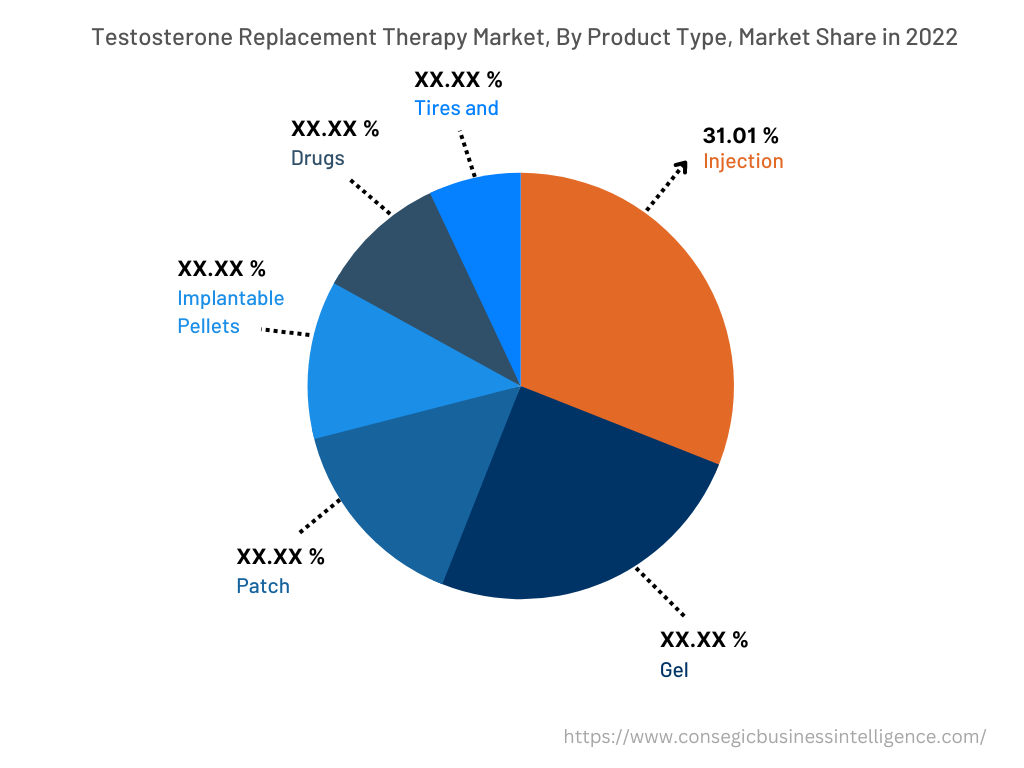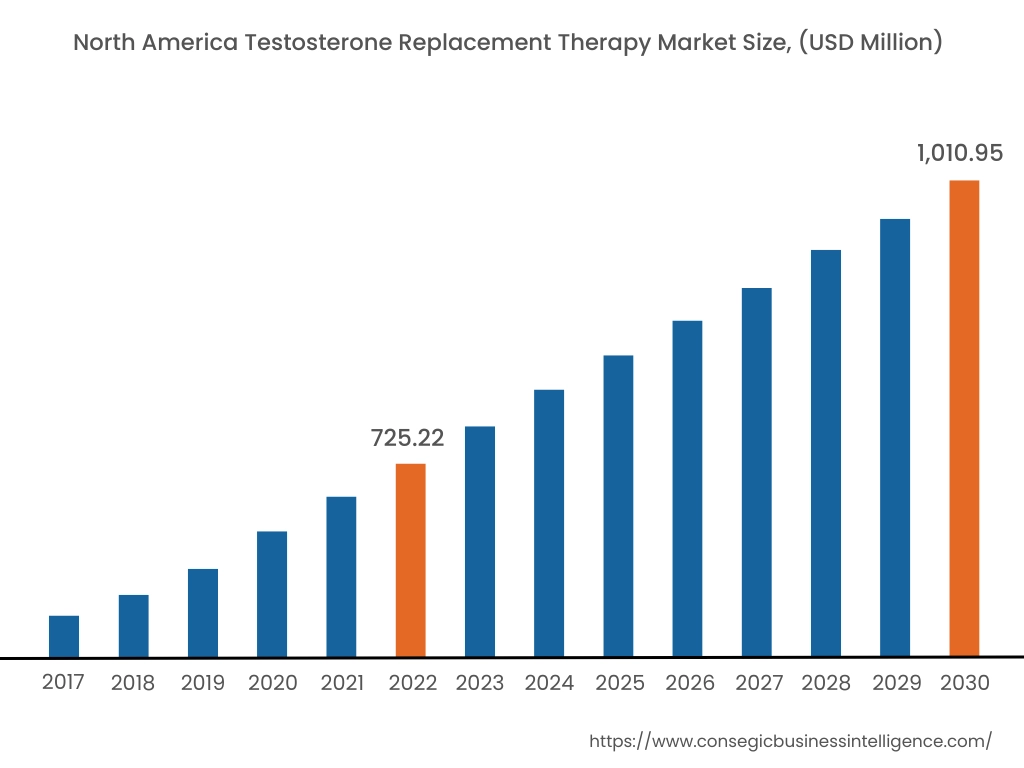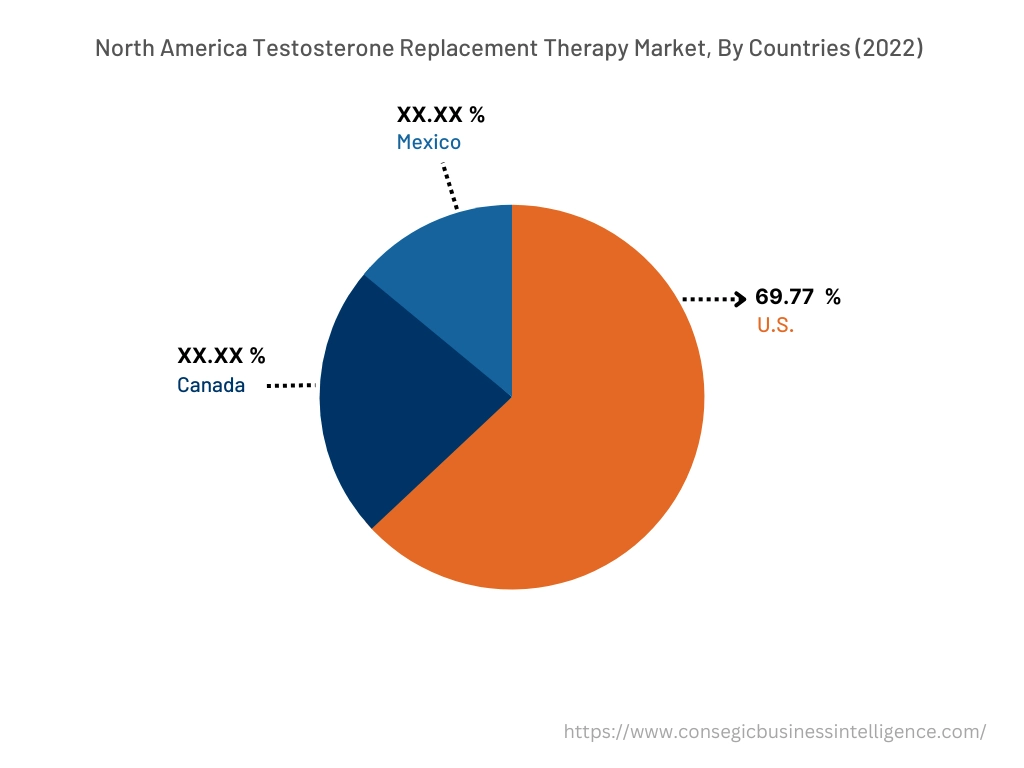Testosterone Replacement Therapy Market Size :
Testosterone Replacement Therapy Market size is estimated to reach over USD 2,696.52 Million by 2032 from a value of USD 1,892.96 Million in 2024 and is projected to grow by USD 1,941.98 Million in 2025, growing at a CAGR of 4.2% from 2025 to 2032.
Testosterone Replacement Therapy Market Scope & Overview:
Testosterone replacement therapy (TRT), also known as androgen replacement therapy, refers to a treatment that is used to address low testosterone levels in men. It involves supplementing or replacing testosterone to improve symptoms associated with hypogonadism, which is a condition where the body does not produce enough testosterone. Moreover, TRT can be administered through various methods such as gels, patches, injections, pellets, or tablets. Androgen replacement therapy can help in alleviating symptoms such as fatigue, decreased muscle mass, low mood, and others, which may be associated with low testosterone levels.
Testosterone Replacement Therapy Market Insights :
Testosterone Replacement Therapy Market Dynamics - (DRO) :
Key Drivers :
Rising prevalence of hypogonadism is propelling the testosterone replacement therapy market growth
The rising prevalence of hypogonadism, a condition characterized by low testosterone levels, is a primary factor driving the testosterone replacement therapy market. Moreover, hypogonadism is becoming more common, particularly in older men and those with conditions such as diabetes and obesity. Additionally, the substantial prevalence of an aging population is also increasing the number of individuals experiencing age-related decline in testosterone production. The above factors are further driving the demand for TRT to alleviate symptoms associated with low testosterone levels, offering patients various options for managing their condition.
- For instance, according to a study published by the American Urological Association (AUA) on October 2024, hypogonadism is a significant medical condition that has been gaining substantial attention in recent years. Further, according to AUA, the prevalence of hypogonadism usually differs, with estimates ranging from 2.1% to 30% in men aged between 40 to 79, depending on the population studied.
Hence, the rising prevalence of hypogonadism is driving the adoption of androgen replacement therapy, in turn proliferating the testosterone replacement therapy market size.
Key Restraints :
Potential health risks and side effects associated with TRT are restraining the testosterone replacement therapy market growth
Testosterone replacement therapy is associated with certain potential health risks and side effects, including cardiovascular issues, prostate problems, sleep apnea, skin reactions, and others, which are key factors limiting its adoption.
For instance, certain studies suggest a potential increased risk of heart attack, stroke, and blood clots, particularly in older men. TRT can worsen benign prostatic hyperplasia (BPH) and potentially stimulate the growth of existing prostate cancer. Additionally, it can also affect existing sleep apnea, which refers to a condition where breathing repeatedly stops and starts during sleep. Further, acne, oily skin, and skin irritation are common side effects, specifically during the initial stages of TRT. Hence, the aforementioned factors are hindering the testosterone replacement therapy market expansion.
Future Opportunities :
Significant advancements in treatment methods are expected to drive the testosterone replacement therapy market opportunities
Androgen replacement therapy has witnessed significant advancements in treatment methods in recent years, including new formulations and delivery systems that aim at improving patient comfort, convenience, and treatment accuracy. Moreover, these advancements mainly include long-acting injections, intravenous injections, nasal gels, and oral testosterone medication options, among others. Consequently, the rising advancements in treatment methods associated with androgen replacement therapy are expected to provide lucrative opportunities for market growth.
- For instance, in August 2022, the Food and Drug Administration (FDA) approved Kyzatrex, a new oral testosterone replacement therapy option for treatment of adult males with conditions related to hypogonadism.
Thus, as per the analysis, the rising advancements in treatment methods associated with androgen replacement therapy are projected to drive the testosterone replacement therapy market opportunities during the forecast period.
Testosterone Replacement Therapy Market Report Insights :
| Report Attributes | Report Details |
| Study Timeline | 2019-2032 |
| Market Size in 2032 | USD 2,696.52 Million |
| CAGR (2025-2032) | 4.2% |
| By Product Type | Gel, Injection, Patch, Implantable Pellets, Drugs, and Others |
| By End User | Hospitals, Homecare, Specialty Clinics, and Others |
| By Region | North America, Europe, Asia-Pacific, Latin America, and Middle East & Africa |
| Key Players | Endo Pharmaceuticals Inc, Pfizer, Inc, Eli Lilly and Company, Bayer AG, Teva Pharmaceutical Industries Ltd, Ferring Pharmaceuticals, Acerus Pharmaceuticals Corporation, Mylan N.V., Upsher-Smith Laboratories, and Biote |
| Geographies Covered | |
| North America | U.S. Canada Mexico |
| Europe | U.K. Germany France Spain Italy Russia Benelux Rest of Europe |
| APAC | China South Korea Japan India Australia ASEAN Rest of Asia-Pacific |
| Middle East and Africa | GCC Turkey South Africa Rest of MEA |
| LATAM | Brazil Argentina Chile Rest of LATAM |
| Report Coverage | Revenue Forecast, Competitive Landscape, Growth Factors, Restraint or Challenges, Opportunities, Environment & Regulatory Landscape, PESTLE Analysis, PORTER Analysis, Key Technology Landscape, Value Chain Analysis, Cost Analysis, and Regional Trends & Forecast |
Testosterone Replacement Therapy Market Segmental Analysis :
By Product Type :
Based on product type, the market is segmented into gel, injection, patch, implantable pellets, drugs, and others.
Trends in the product type:
- Increasing trend in adoption of injections for androgen replacement therapy due to its increased efficacy and consistency, precise dosing, and increased convenience is driving the testosterone replacement therapy market size.
- There is a rising trend towards the utilization of testosterone gels for androgen replacement therapy, due to its several benefits such as increased muscle mass and strength, enhanced mood, increased energy levels, improved bone density, and others.
The injection segment accounted for the largest revenue share of 39.57% in the total testosterone replacement therapy market share in 2024.
- Injections are a common method used in androgen replacement therapy to treat low testosterone levels in men.
- These injections are typically administered intramuscularly and involve replacing the testosterone that the body is not producing in sufficient quantities.
- Moreover, injections offer a reliable and effective way to deliver testosterone while maintaining stable blood levels.
- Injections also enable precise dosing and close monitoring of treatment efficacy by healthcare professionals.
- Additionally, the use of injections in therapy often provides longer-lasting effects along with reducing the frequency of administration.
- According to the testosterone replacement therapy market analysis, the above benefits are driving the adoption of TRT injections, in turn propelling the testosterone replacement therapy market trends.
The gel segment is anticipated to register a substantial CAGR growth during the forecast period.
- Testosterone gels are a common form of androgen replacement therapy. Testosterone gel is a topical medication that is typically applied to the skin and used for treating low testosterone levels in men.
- It delivers the hormone testosterone directly into the bloodstream through the skin for restoring testosterone to normal levels.
- Moreover, the gel is applied to the skin, usually once a day, and the testosterone is absorbed through the skin into the bloodstream. This method provides a more gradual and consistent absorption in comparison to some other forms of testosterone replacement therapy.
- Additionally, it helps to ease symptoms associated with low testosterone levels, such as fatigue, muscle loss, and others.
- Thus, the above benefits of testosterone gels are projected to drive its adoption for androgen replacement therapy, in turn boosting the market demand during the forecast period.

By End User :
Based on the end-user, the market is segmented into hospitals, homecare, specialty clinics, and others.
Trends in the end-user:
- Hospitals are increasingly adopting advanced and specialized treatment options for offering comprehensive care to patients with lower testosterone levels, which is further driving the market trends.
- Increasing trend in adoption of androgen replacement therapy from specialty clinics to attain specialized and targeted care from health specialists, while ensuring a comprehensive approach to treatment.
The hospitals segment accounted for a substantial revenue share in the overall testosterone replacement therapy market share in 2024.
- Hospitals play a vital role in the treatment of lower testosterone levels by providing several advanced methods and treatment options for androgen replacement therapy.
- Moreover, hospitals are widely preferred by patients for androgen replacement therapy, due to the prevalence of well-developed infrastructure, advanced technology, and skilled healthcare professionals.
- For instance, Apollo Hospital is a prominent hospital network chain in India that offers androgen replacement therapy in its service offerings.
- According to the analysis, the prevalence of substantial number of hospitals offering androgen replacement therapy is further propelling the market.
The specialty clinics segment is anticipated to register a significant CAGR growth during the forecast period.
- Specialty clinics refer to healthcare facilities that primarily focus on a particular area of healthcare or a specific type of medical condition.
- Similarly, these clinics are staffed by healthcare professionals who specialize in diagnosing and treating patients with specific health issues.
- Moreover, specialty clinics for androgen replacement therapy focus on diagnosing and treating low testosterone levels in men.
- These clinics offer a more targeted and focused approach to therapy, often providing specialized treatments and personalized care plans.
- For instance, Cleveland Clinic offers TRT in its service offerings. Cleveland Clinic’s expert healthcare providers offer a personalized treatment plan that focuses on each individual’s distinct symptoms.
- Thus, the growing number of specialty clinics offering androgen replacement therapy is projected to drive the market growth during the forecast period.
By Region :
The regions covered are North America, Europe, Asia Pacific, the Middle East and Africa, and Latin America.

Asia Pacific region was valued at USD 446.68 Million in 2024. Moreover, it is projected to grow by USD 460.44 Million in 2025 and reach over USD 672.78 Million by 2032. Out of this, China accounted for the maximum revenue share of 30.68%. As per the testosterone replacement therapy market analysis, the adoption of androgen replacement therapy in the Asia-Pacific region is primarily driven by the growing healthcare industry, increasing prevalence of hypogonadism, along with the rising development of hospitals and treatment centers focusing on hormone replacement therapy in the region. Moreover, the increasing development of hospitals and specialty clinics is further driving the adoption of androgen replacement therapy for the treatment of hypogonadism, which is further accelerating the testosterone replacement therapy market expansion.
- For instance, Fortis Hospital, an India-based private hospital network, offers androgen replacement therapy in its service offerings. The hospital is committed to a patient-first approach, focusing on comprehensive health improvement and longevity through personalized TRT. The above factors are further propelling the testosterone replacement therapy market trends in the Asia-Pacific region.

North America is estimated to reach over USD 1,073.22 Million by 2032 from a value of USD 748.62 Million in 2024 and is projected to grow by USD 768.42 Million in 2025. In North America, the growth of testosterone replacement therapy industry is driven by significant cases of hypogonadism and rising advancements in TRT treatment options among others. Moreover, the rising investments in research & development (R&D) activities associated with hormone replacement therapy is further contributing to the testosterone replacement therapy market demand.
Additionally, the regional analysis depicts that the rising investments in R&D activities for androgen replacement therapy, along with the prevalence of advanced hospitals and healthcare centers, equipped with modern diagnostic technology and skilled healthcare professionals, are driving the testosterone replacement therapy market demand in Europe. Further, according to the market analysis, the market demand in Latin America, Middle East, and African regions is anticipated to grow at a significant rate due to factors including the growing healthcare sector and development of healthcare facilities, including hospitals and specialty clinics focusing on androgen replacement therapy.
Top Key Players & Market Share Insights :
The global testosterone replacement therapy market is highly competitive with major players providing solutions to the national and international markets. Key players are adopting several strategies in research and development (R&D), product innovation, and end-user launches to hold a strong position in the testosterone replacement therapy market. Key players in the testosterone replacement therapy industry include-
- Endo Pharmaceuticals Inc. (U.S)
- Pfizer Inc. (U.S)
- Acerus Pharmaceuticals Corporation (Canada)
- Mylan N.V. (U.S)
- Upsher-Smith Laboratories (U.S)
- Biote Medical LLC (U.S)
- Eli Lilly and Company (U.S)
- Bayer AG (Germany)
- Teva Pharmaceutical Industries Ltd (Israel)
- Ferring Pharmaceuticals (Switzerland)
Recent Industry Developments :
- In September 2024, WellSync collaborated with Marius Pharmaceuticals, with the aim of offering KYZATREX (testosterone undecanoate) CIII capsules, which are an oral form of TRT, on WellSync’s inclusive virtual care platform. This initiative exhibits WellSync’s ability to integrate seamlessly with pharmaceutical products, in turn providing an innovative direct-to-patient healthcare solution.
Key Questions Answered in the Report
How big is the testosterone replacement therapy market? +
The testosterone replacement therapy market was valued at USD 1,892.96 Million in 2024 and is projected to grow to USD 2,696.52 Million by 2032.
Which is the fastest-growing region in the testosterone replacement therapy market? +
Asia-Pacific is the region experiencing the most rapid growth in the testosterone replacement therapy market.
What specific segmentation details are covered in the testosterone replacement therapy report? +
The testosterone replacement therapy report includes specific segmentation details for product type, end-user, and region.
Who are the major players in the testosterone replacement therapy market? +
The key participants in the testosterone replacement therapy market are Endo Pharmaceuticals Inc. (U.S), Pfizer Inc. (U.S), Biote Medical LLC (U.S), Eli Lilly and Company (U.S), Bayer AG (Germany), Teva Pharmaceutical Industries Ltd (Israel), Ferring Pharmaceuticals (Switzerland), Acerus Pharmaceuticals Corporation (Canada), Mylan N.V. (U.S), Upsher-Smith Laboratories (U.S), and others.
Based on current market trends and future predictions, which geographical region is the dominating region in the testosterone replacement therapy market? +
North America accounted for the highest market share in the overall testosterone replacement therapy market.


